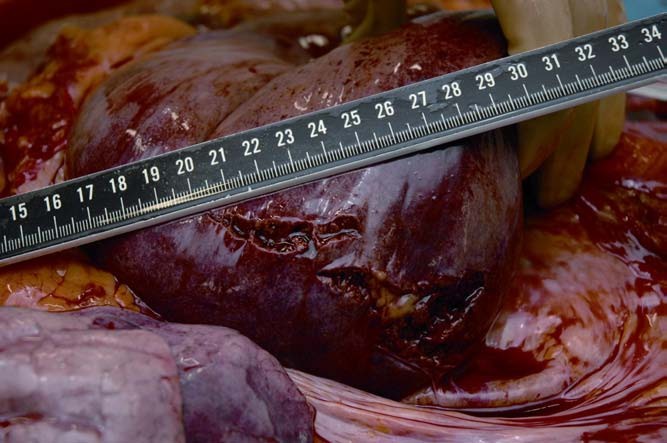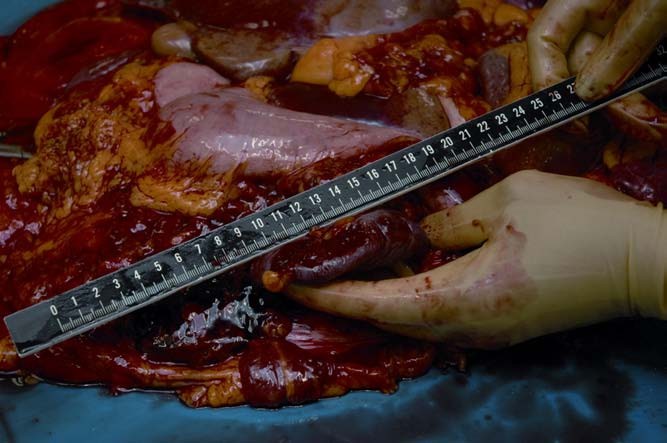Extensive injury after use of a mechanical cardiopulmonary resuscitation device
Case Report
Extensive injury after use of a mechanical cardiopulmonary resuscitation device
Abstract
We report a case of a 49-year-old woman with a ruptured liver and spleen found at autopsy, which may have been related to the use of a mechanical cardiopulmonary resuscitation (CPR) device (AutoPulse, ZOLL Medical Corporation, Chelmsford, Mass). She was admitted because of an out-of-hospital resuscitation, and under the suspicion of a pulmonary embolism, a thrombolytic agent was adminis- tered. Despite prolonged continuation of mechanical CPR, she died of persistent asystole. The evidence for improved outcomes after the use of a mechanical CPR device during resuscitation is still scarce. To prevent the unique complica- tions reported here, regular checking of proper position of the chest band during resuscitation is advised.
One day after an uncomplicated arthroscopy, a 49-year-old otherwise healthy woman suddenly collapsed at home, witnessed by her daughter, who notified the emergency service. On their arrival, the initial rhythm was asystole and she was found gasping. Advanced cardiac life support was started immediately, but asystole remained despite high doses of epinephrine, atropine, and adequate cardiopulmonary resusci- tation (CPR). Forty-five minutes after start of resuscitation, she



Fig. 2 Rupture of the spleen.
arrived at the emergency department. Echocardiography confirmed cardiac standstill and a dilated right ventricle without other abnormalities. A massive pulmonary embolism was suspected and intravenous tenecteplase (8000 IU) was administered as a bolus, after which chest compression was continued, using a mechanical CPR device (AutoPulse) [1]. Because asystole persisted after a total of 105 minutes, resuscitation was stopped and our patient died.
At autopsy, no pulmonary embolus was found, but there were ruptures of liver (Fig. 1) and spleen (Fig. 2) with 1 L of abdominal blood. Added to bilateral dorsal rib fractures, a fractured manubrium of the sternum, and lateral cutaneous lacerations, this strongly suggested a relation with use of the device; however, a relation with previous manual external chest compressions cannot be excluded. Microscopy showed recent and prolonged ischemic injury of the myocardium.
The AutoPulse is an automatic electromechanical device compressing the anterior chest. With the AutoPulse, a higher rate of chest compressions of equal quality can be realized as compared with manual chest compressions [1]. The advan- tages of mechanical CPR are still unresolved because 2 studies have shown contradictory outcome results [2,3] Hemoperitoneum, contusion of the liver, and cutaneous abrasions have been previously described complications of mechanical CPR devices [4,5]. Our case demonstrates the occurrence of intra-abdominal organ rupture after manual external chest compressions and the use of the AutoPulse in
0735-6757/$ - see front matter (C) 2009
combination with thrombolytic therapy. This may have been related to inappropriate position of the band, which may have slid more caudally during mechanical CPR. We therefore recommend that proper position of the band is regularly checked when using the AutoPulse to prevent injury.
J. Wind MSc
Department of Surgery Maastricht University Medical Centre PO BOX 5800, 6202 AZ Maastricht
The Netherlands E-mail address: t.wind@mumc.nl
S.C.A.M. Bekkers MD
Department of Cardiology Maastricht University Medical Centre
The Netherlands
L.J.H. van Hooren MD
Department of Forensic Medicine GGD Zuid-Limburg
The Netherlands
L.W.E. van Heurn MD, PhD
Department of Surgery Maastricht University Medical Centre
doi:10.1016/j.ajem.2008.11.018
References
- Timerman S, Cardoso LF, Ramires JA, Halperin H. Improved hemodynamic performance with a novel chest compression device during treatment of in-hospital cardiac arrest. 2004;61:273-80.
- Hallstrom AL, Rea TD, Sayre MR, et al. Manual chest compression vs use of an automated chest compression device during resuscitation following out-of-hospital cardiac arrest: a randomized trial. JAMA 2006;295(22):2620-8.
- Ong MEH, Ornaat JP, Edwards DP, et al. Use of an automated, load- distributing band chest compression device for out-of-hospital cardiac arrest resuscitation. JAMA 2006;295(22):2629-37.
- Fanton L, David JS, Gueugiaud PY, Malacier D. Forensic aspects of automated chest compression. Resuscitation 2008;77:273-2744.
- Hart AP, Azar VJ, Hart KR, Stephens BG. Autopsy artefact created by the revivant Auto Pulse resuscitation device. J Forensic Sci 2005;50.
